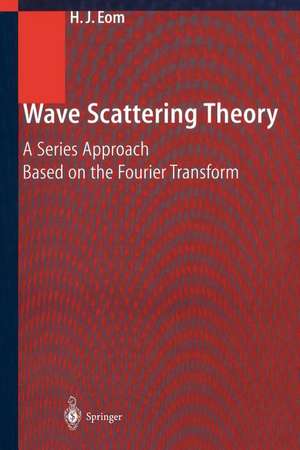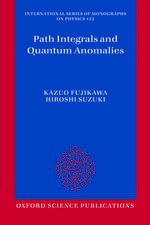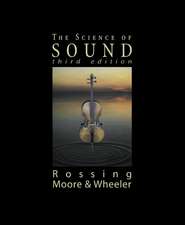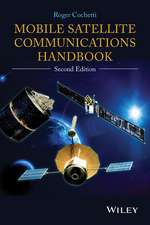Wave Scattering Theory: A Series Approach Based on the Fourier Transformation
Autor Hyo J. Eomen Limba Engleză Paperback – 18 sep 2011
Preț: 386.00 lei
Nou
Puncte Express: 579
Preț estimativ în valută:
73.87€ • 80.21$ • 62.05£
73.87€ • 80.21$ • 62.05£
Carte tipărită la comandă
Livrare economică 22 aprilie-06 mai
Preluare comenzi: 021 569.72.76
Specificații
ISBN-13: 9783642639951
ISBN-10: 364263995X
Pagini: 260
Ilustrații: XII, 244 p.
Dimensiuni: 155 x 235 x 14 mm
Greutate: 0.37 kg
Ediția:Softcover reprint of the original 1st ed. 2001
Editura: Springer Berlin, Heidelberg
Colecția Springer
Locul publicării:Berlin, Heidelberg, Germany
ISBN-10: 364263995X
Pagini: 260
Ilustrații: XII, 244 p.
Dimensiuni: 155 x 235 x 14 mm
Greutate: 0.37 kg
Ediția:Softcover reprint of the original 1st ed. 2001
Editura: Springer Berlin, Heidelberg
Colecția Springer
Locul publicării:Berlin, Heidelberg, Germany
Public țintă
ResearchCuprins
1. Rectangular Grooves in a Plane.- 1.1 EM Scattering from a Rectangular Groove in a Conducting Plane.- 1.2 EM Scattering from Multiple Grooves in a Conducting Plane.- 1.3 EM Scattering from Grooves in a Dielectric-Covered Ground Plane.- 1.4 EM Scattering from Rectangular Grooves in a Parallel-Plate Waveguide.- 1.5 EM Scattering from Double Grooves in Parallel Plates [18].- 1.6 Water Wave Scattering from Rectangular Grooves in a Plane.- References for Chapter 1.- 2. Flanged Parallel-Plate Waveguide Array.- 2.1 EM Radiation from a Flanged Parallel-Plate Waveguide.- 2.2 EM Radiation from a Parallel-Plate Waveguide into a Dielectric Slab.- 2.3 TE Scattering from a Parallel-Plate Waveguide Array [18].- 2.4 EM Radiation from Obliquely-Flanged Parallel Plates.- 2.5 EM Radiation from Parallel Plates with a Window [24].- References for Chapter 2.- 3. Slits in a Plane.- 3.1 Electrostatic Potential Distribution Through a Slit in a Plane [1].- 3.2 Electrostatic Potential Distribution due to a Potential Across a Slit [3].- 3.3 EM Scattering from a Slit in a Conducting Plane.- 3.4 Magnetostatic Potential Distribution Through Slits in a Plane.- 3.5 EM Scattering from Slits in a Conducting Plane [13].- 3.6 EM Scattering from Slits in a Parallel-Plate Waveguide.- 3.7 EM Scattering from Slits in a Rectangular Cavity.- 3.8 EM Scattering from Slits in Parallel-Conducting Planes [31].- References for Chapter 3.- 4. Waveguides and Couplers.- 4.1 Inset Dielectric Guide.- 4.2 Groove Guide [4].- 4.3 Multiple Groove Guide [8].- 4.4 Corrugated Coaxial Line [10].- 4.5 Coaxial Line with a Gap [13].- 4.6 Coaxial Line with a Cavity [16].- 4.7 Corrugated Circular Cylinder [18].- 4.8 Parallel-Plate Double Slit Directional Coupler [23].- 4.9 Parallel-Plate Multiple Slit Directional Coupler [29].- References for Chapter 4.- 5. Junctions in Parallel-Plate/Rectangular Waveguide.- 5.1 T-Junction in a Parallel-Plate Waveguide.- 5.2 E-Plane T-Junction in a Rectangular Waveguide [6].- 5.3 H-Plane Double Junction [8].- 5.4 H-Plane Double Bend [9].- 5.5 Acoustic Double Junction in a Rectangular Waveguide [11].- 5.6 Acoustic Hybrid Junction in a Rectangular Waveguide [15].- References for Chapter 5.- 6. Rectangular Apertures in a Plane.- 6.1 Static Potential Through a Rectangular Aperture in a Plane.- 6.2 Acoustic Scattering from a Rectangular Aperture in a Hard Plane [7].- 6.3 Electrostatic Potential Through Rectangular Apertures in a Plane [9].- 6.4 Magnetostatic Potential Through Rectangular Apertures in a Plane [10].- 6.5 EM Scattering from Rectangular Apertures in a Conducting Plane [11].- 6.6 EM Scattering from Rectangular Apertures in a Rectangular Cavity [18].- References for Chapter 6.- 7. Circular Apertures in a Plane.- 7.1 Static Potential Through a Circular Aperture in a Plane.- 7.2 Acoustic Scattering from a Circular Aperture in a Hard Plane [6].- 7.3 EM Scattering from a Circular Aperture in a Conducting Plane.- 7.4 Acoustic Radiation from a Flanged Circular Cylinder [15].- 7.5 Acoustic Scattering from Circular Apertures in a Hard Plane [17].- 7.6 Acoustic Radiation from Circular Cylinders in a Hard Plane [19].- References for Chapter 7.- 8. Annular Aperture in a Plane.- 8.1 Static Potential Through an Annular Aperture in a Plane.- 8.2 EM Radiation from a Coaxial Line into a Parallel-Plate Waveguide [6].- 8.3 EM Radiation from a Coaxial Line into a Dielectric Slab [10].- 8.4 EM Radiation from a Monopole into a Parallel-Plate Waveguide [17].- References for Chapter 8.- 9. Circumferential Apertures on a Circular Cylinder.- 9.1 EM Radiation from an Aperture on a Shorted Coaxial Line [1].- 9.2 EM Radiation from Apertures on a Shorted Coaxial Line [3].- 9.3 EM Radiation from Apertures on a Coaxial Line [4].- 9.4 EM Radiation from Apertures on a Coaxial Line with a Cover [6].- 9.5 EM Radiation from Apertures on a Circular Cylinder [10].- References for Chapter 9.- A. Appendix.- A.1 Vector Potentials and Field Representations.
Textul de pe ultima copertă
The book provides a unified technique of Fourier transform to solve the wave scattering, diffraction, penetration, and radiation problems where the technique of separation of variables is applicable. The book discusses wave scattering from waveguide discontinuities, various apertures, and coupling structures, often encountered in electromagnetic, electrostatic, magnetostatic, and acoustic problems. A system of simultaneous equations for the modal coefficients is formulated and the rapidly-convergent series solutions amenable to numerical computation are presented. The series solutions find practical applications in the design of microwave/acoustic transmission lines, waveguide filters, antennas, and electromagnetic interference/compatibilty-related problems.
Caracteristici
Useful for graduate students, scientists and engineers in electromagnetic wave-related areas Addresses canonical wave scattering problems and presents a simple series approach based on the Fourier transform The theory presented in the monograph finds practical applications in microwaves, antenna, optics as well as acoustics Includes supplementary material: sn.pub/extras
















